HRM Assignment: Analysis of HRM Practices in an Organization
VerifiedAdded on 2020/02/05
|21
|6169
|41
Report
AI Summary
This report delves into various aspects of Human Resource Management (HRM), providing a comprehensive overview of key practices and strategies. It begins with an introduction to the nature and scope of HRM, followed by an examination of workforce planning, exploring concepts like permanent and contractual labor, PESTLE analysis, and employee turnover. The report then analyzes learning development and training, job and workplace design, and the flexible organization. It also covers performance and reward systems. Furthermore, the report provides an analysis of the importance of maintaining good employee relations for ITV and how it influences their HR decisions. It also identifies key elements in employment legislation and how it affects ITV's HR decisions. Finally, the report includes a job advertisement for an assistant professor, identifies suitable platforms for placement, prepares job and person specifications, and offers a rationale for applying specific HRM practices.
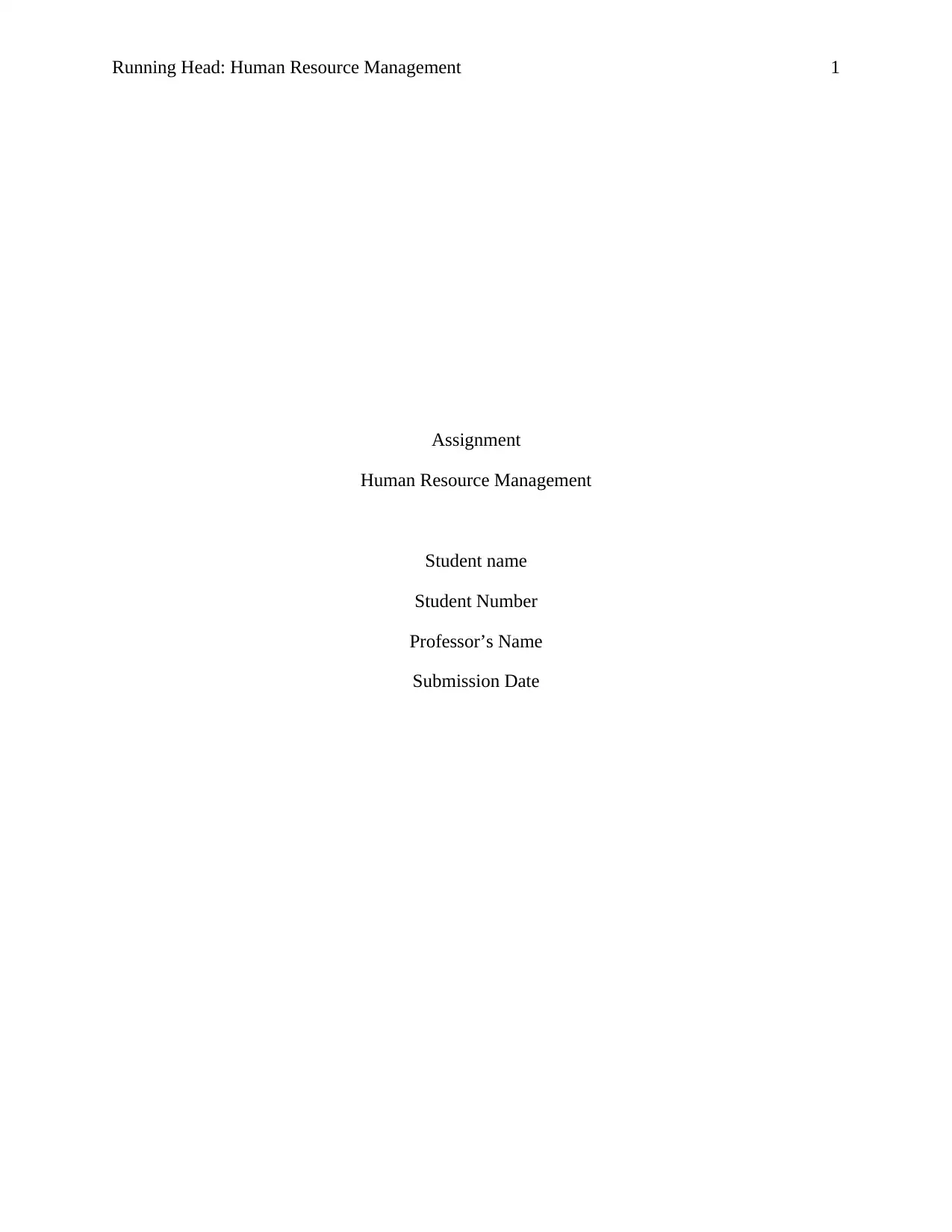
Running Head: Human Resource Management 1
Assignment
Human Resource Management
Student name
Student Number
Professor’s Name
Submission Date
Assignment
Human Resource Management
Student name
Student Number
Professor’s Name
Submission Date
Paraphrase This Document
Need a fresh take? Get an instant paraphrase of this document with our AI Paraphraser
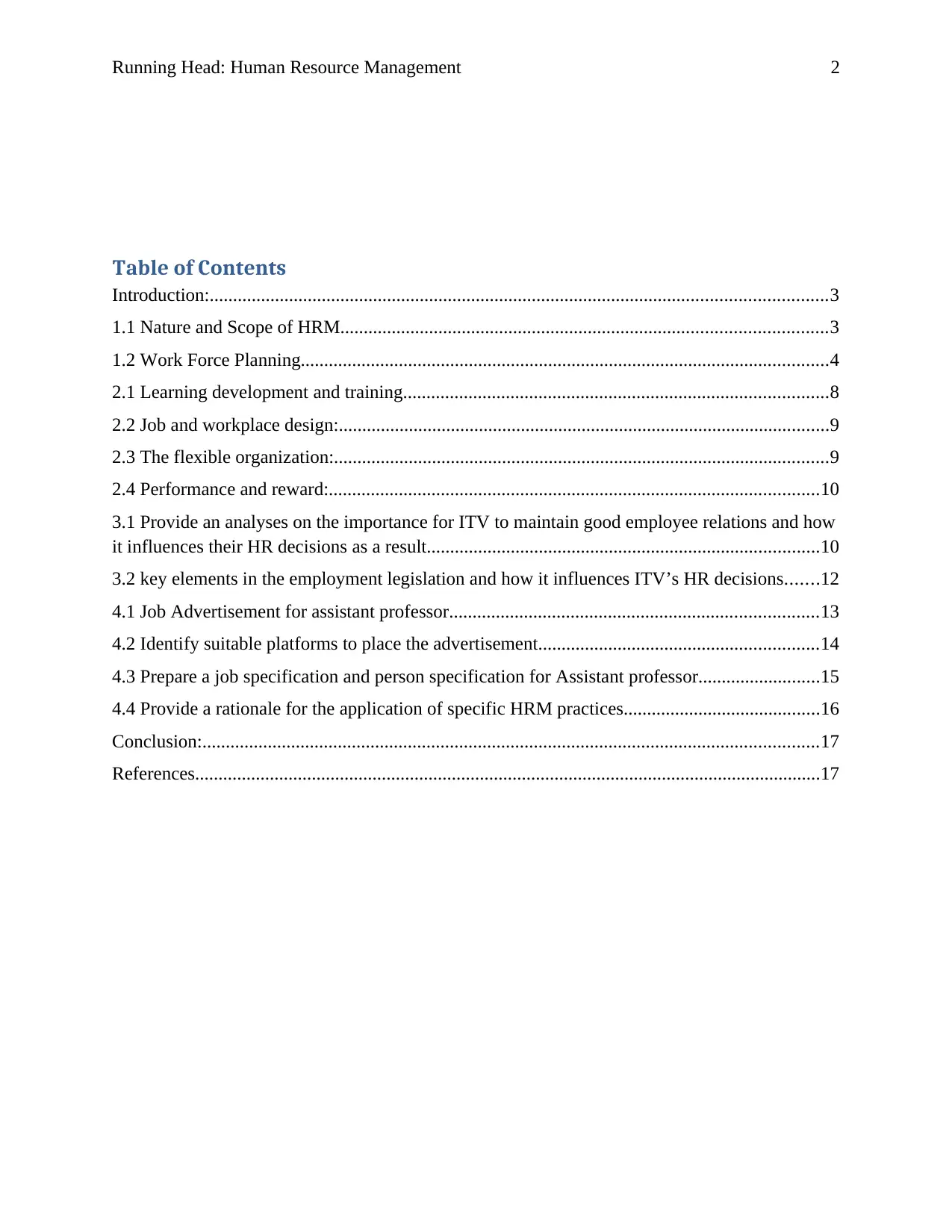
Running Head: Human Resource Management 2
Table of Contents
Introduction:....................................................................................................................................3
1.1 Nature and Scope of HRM........................................................................................................3
1.2 Work Force Planning.................................................................................................................4
2.1 Learning development and training...........................................................................................8
2.2 Job and workplace design:.........................................................................................................9
2.3 The flexible organization:..........................................................................................................9
2.4 Performance and reward:.........................................................................................................10
3.1 Provide an analyses on the importance for ITV to maintain good employee relations and how
it influences their HR decisions as a result....................................................................................10
3.2 key elements in the employment legislation and how it influences ITV’s HR decisions.......12
4.1 Job Advertisement for assistant professor...............................................................................13
4.2 Identify suitable platforms to place the advertisement............................................................14
4.3 Prepare a job specification and person specification for Assistant professor..........................15
4.4 Provide a rationale for the application of specific HRM practices..........................................16
Conclusion:....................................................................................................................................17
References......................................................................................................................................17
Table of Contents
Introduction:....................................................................................................................................3
1.1 Nature and Scope of HRM........................................................................................................3
1.2 Work Force Planning.................................................................................................................4
2.1 Learning development and training...........................................................................................8
2.2 Job and workplace design:.........................................................................................................9
2.3 The flexible organization:..........................................................................................................9
2.4 Performance and reward:.........................................................................................................10
3.1 Provide an analyses on the importance for ITV to maintain good employee relations and how
it influences their HR decisions as a result....................................................................................10
3.2 key elements in the employment legislation and how it influences ITV’s HR decisions.......12
4.1 Job Advertisement for assistant professor...............................................................................13
4.2 Identify suitable platforms to place the advertisement............................................................14
4.3 Prepare a job specification and person specification for Assistant professor..........................15
4.4 Provide a rationale for the application of specific HRM practices..........................................16
Conclusion:....................................................................................................................................17
References......................................................................................................................................17
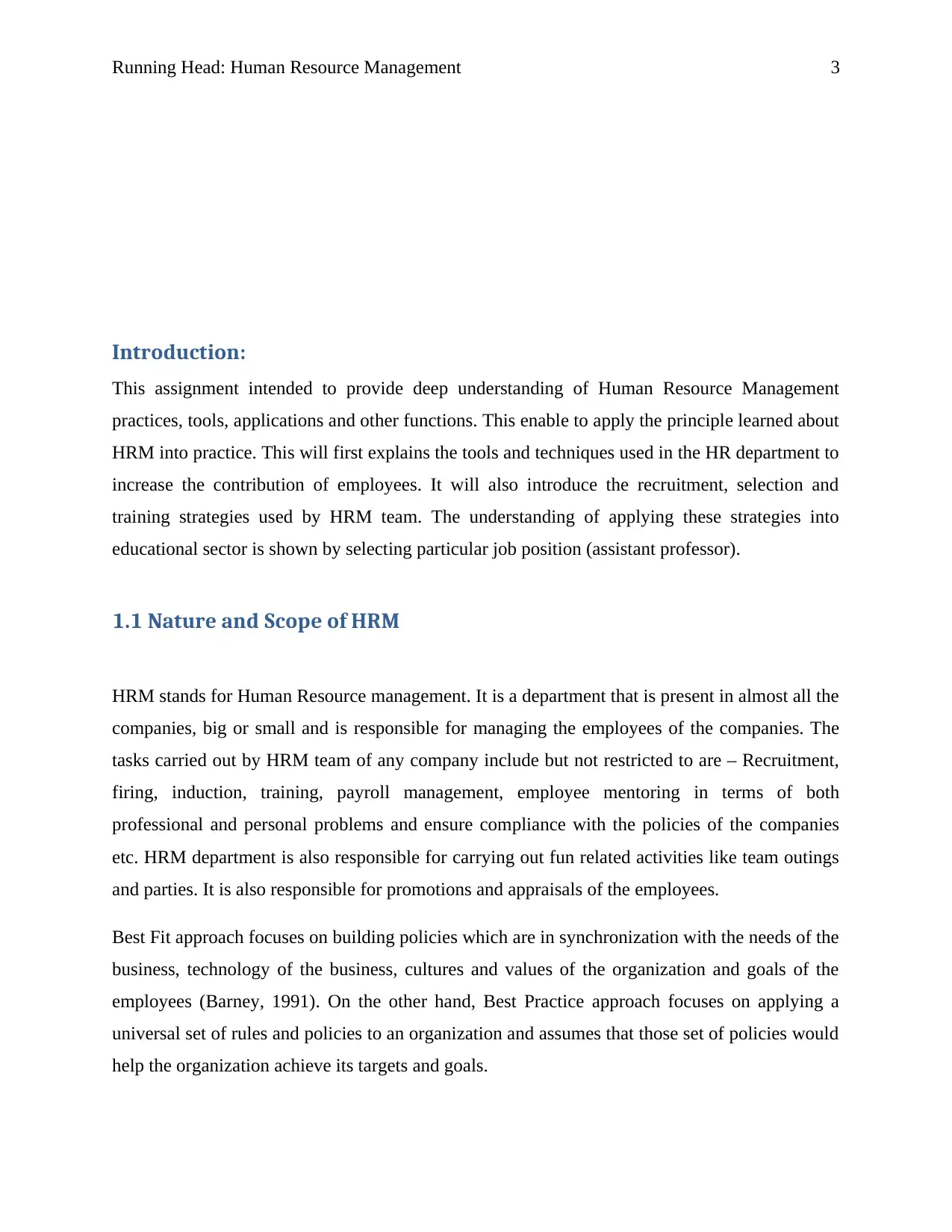
Running Head: Human Resource Management 3
Introduction:
This assignment intended to provide deep understanding of Human Resource Management
practices, tools, applications and other functions. This enable to apply the principle learned about
HRM into practice. This will first explains the tools and techniques used in the HR department to
increase the contribution of employees. It will also introduce the recruitment, selection and
training strategies used by HRM team. The understanding of applying these strategies into
educational sector is shown by selecting particular job position (assistant professor).
1.1 Nature and Scope of HRM
HRM stands for Human Resource management. It is a department that is present in almost all the
companies, big or small and is responsible for managing the employees of the companies. The
tasks carried out by HRM team of any company include but not restricted to are – Recruitment,
firing, induction, training, payroll management, employee mentoring in terms of both
professional and personal problems and ensure compliance with the policies of the companies
etc. HRM department is also responsible for carrying out fun related activities like team outings
and parties. It is also responsible for promotions and appraisals of the employees.
Best Fit approach focuses on building policies which are in synchronization with the needs of the
business, technology of the business, cultures and values of the organization and goals of the
employees (Barney, 1991). On the other hand, Best Practice approach focuses on applying a
universal set of rules and policies to an organization and assumes that those set of policies would
help the organization achieve its targets and goals.
Introduction:
This assignment intended to provide deep understanding of Human Resource Management
practices, tools, applications and other functions. This enable to apply the principle learned about
HRM into practice. This will first explains the tools and techniques used in the HR department to
increase the contribution of employees. It will also introduce the recruitment, selection and
training strategies used by HRM team. The understanding of applying these strategies into
educational sector is shown by selecting particular job position (assistant professor).
1.1 Nature and Scope of HRM
HRM stands for Human Resource management. It is a department that is present in almost all the
companies, big or small and is responsible for managing the employees of the companies. The
tasks carried out by HRM team of any company include but not restricted to are – Recruitment,
firing, induction, training, payroll management, employee mentoring in terms of both
professional and personal problems and ensure compliance with the policies of the companies
etc. HRM department is also responsible for carrying out fun related activities like team outings
and parties. It is also responsible for promotions and appraisals of the employees.
Best Fit approach focuses on building policies which are in synchronization with the needs of the
business, technology of the business, cultures and values of the organization and goals of the
employees (Barney, 1991). On the other hand, Best Practice approach focuses on applying a
universal set of rules and policies to an organization and assumes that those set of policies would
help the organization achieve its targets and goals.
⊘ This is a preview!⊘
Do you want full access?
Subscribe today to unlock all pages.

Trusted by 1+ million students worldwide
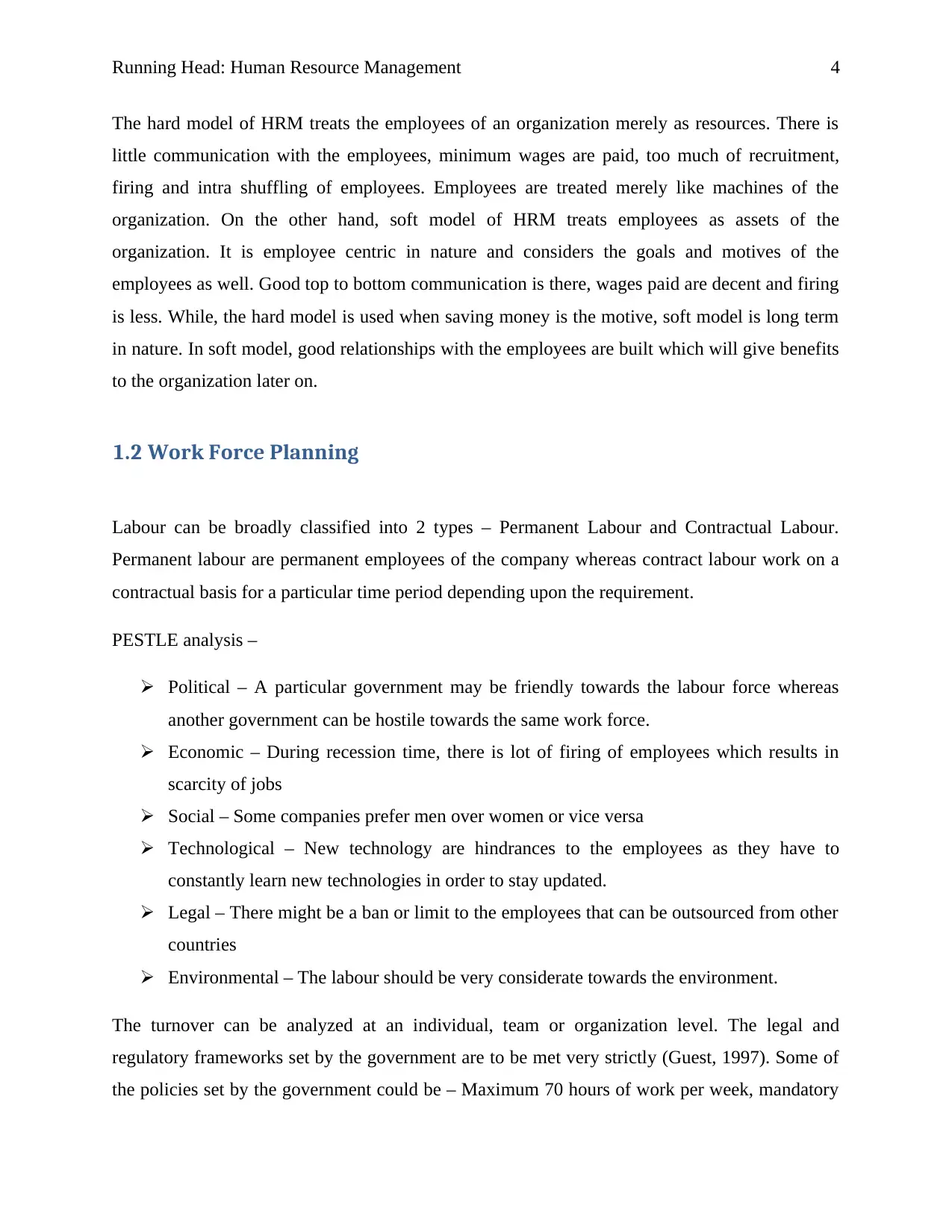
Running Head: Human Resource Management 4
The hard model of HRM treats the employees of an organization merely as resources. There is
little communication with the employees, minimum wages are paid, too much of recruitment,
firing and intra shuffling of employees. Employees are treated merely like machines of the
organization. On the other hand, soft model of HRM treats employees as assets of the
organization. It is employee centric in nature and considers the goals and motives of the
employees as well. Good top to bottom communication is there, wages paid are decent and firing
is less. While, the hard model is used when saving money is the motive, soft model is long term
in nature. In soft model, good relationships with the employees are built which will give benefits
to the organization later on.
1.2 Work Force Planning
Labour can be broadly classified into 2 types – Permanent Labour and Contractual Labour.
Permanent labour are permanent employees of the company whereas contract labour work on a
contractual basis for a particular time period depending upon the requirement.
PESTLE analysis –
Political – A particular government may be friendly towards the labour force whereas
another government can be hostile towards the same work force.
Economic – During recession time, there is lot of firing of employees which results in
scarcity of jobs
Social – Some companies prefer men over women or vice versa
Technological – New technology are hindrances to the employees as they have to
constantly learn new technologies in order to stay updated.
Legal – There might be a ban or limit to the employees that can be outsourced from other
countries
Environmental – The labour should be very considerate towards the environment.
The turnover can be analyzed at an individual, team or organization level. The legal and
regulatory frameworks set by the government are to be met very strictly (Guest, 1997). Some of
the policies set by the government could be – Maximum 70 hours of work per week, mandatory
The hard model of HRM treats the employees of an organization merely as resources. There is
little communication with the employees, minimum wages are paid, too much of recruitment,
firing and intra shuffling of employees. Employees are treated merely like machines of the
organization. On the other hand, soft model of HRM treats employees as assets of the
organization. It is employee centric in nature and considers the goals and motives of the
employees as well. Good top to bottom communication is there, wages paid are decent and firing
is less. While, the hard model is used when saving money is the motive, soft model is long term
in nature. In soft model, good relationships with the employees are built which will give benefits
to the organization later on.
1.2 Work Force Planning
Labour can be broadly classified into 2 types – Permanent Labour and Contractual Labour.
Permanent labour are permanent employees of the company whereas contract labour work on a
contractual basis for a particular time period depending upon the requirement.
PESTLE analysis –
Political – A particular government may be friendly towards the labour force whereas
another government can be hostile towards the same work force.
Economic – During recession time, there is lot of firing of employees which results in
scarcity of jobs
Social – Some companies prefer men over women or vice versa
Technological – New technology are hindrances to the employees as they have to
constantly learn new technologies in order to stay updated.
Legal – There might be a ban or limit to the employees that can be outsourced from other
countries
Environmental – The labour should be very considerate towards the environment.
The turnover can be analyzed at an individual, team or organization level. The legal and
regulatory frameworks set by the government are to be met very strictly (Guest, 1997). Some of
the policies set by the government could be – Maximum 70 hours of work per week, mandatory
Paraphrase This Document
Need a fresh take? Get an instant paraphrase of this document with our AI Paraphraser
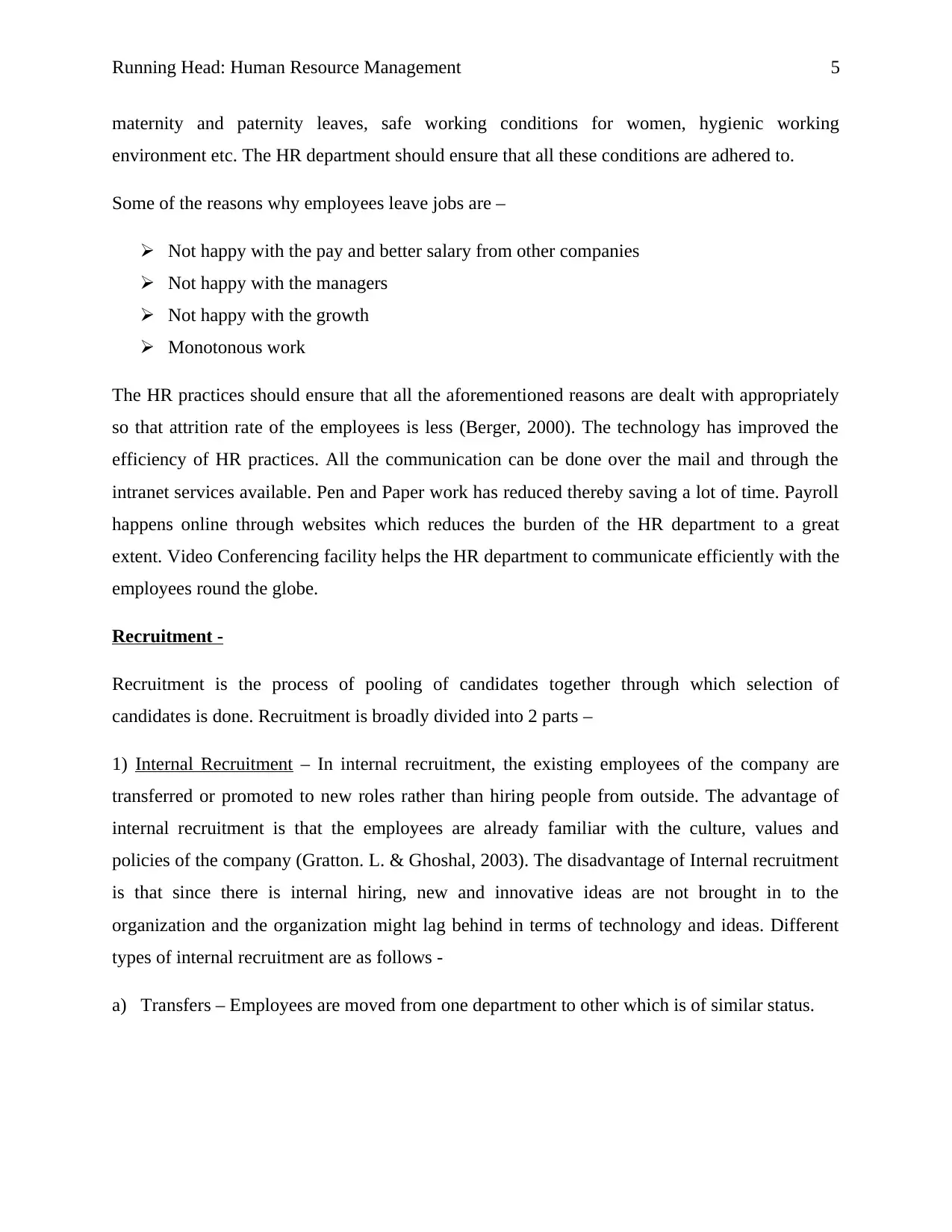
Running Head: Human Resource Management 5
maternity and paternity leaves, safe working conditions for women, hygienic working
environment etc. The HR department should ensure that all these conditions are adhered to.
Some of the reasons why employees leave jobs are –
Not happy with the pay and better salary from other companies
Not happy with the managers
Not happy with the growth
Monotonous work
The HR practices should ensure that all the aforementioned reasons are dealt with appropriately
so that attrition rate of the employees is less (Berger, 2000). The technology has improved the
efficiency of HR practices. All the communication can be done over the mail and through the
intranet services available. Pen and Paper work has reduced thereby saving a lot of time. Payroll
happens online through websites which reduces the burden of the HR department to a great
extent. Video Conferencing facility helps the HR department to communicate efficiently with the
employees round the globe.
Recruitment -
Recruitment is the process of pooling of candidates together through which selection of
candidates is done. Recruitment is broadly divided into 2 parts –
1) Internal Recruitment – In internal recruitment, the existing employees of the company are
transferred or promoted to new roles rather than hiring people from outside. The advantage of
internal recruitment is that the employees are already familiar with the culture, values and
policies of the company (Gratton. L. & Ghoshal, 2003). The disadvantage of Internal recruitment
is that since there is internal hiring, new and innovative ideas are not brought in to the
organization and the organization might lag behind in terms of technology and ideas. Different
types of internal recruitment are as follows -
a) Transfers – Employees are moved from one department to other which is of similar status.
maternity and paternity leaves, safe working conditions for women, hygienic working
environment etc. The HR department should ensure that all these conditions are adhered to.
Some of the reasons why employees leave jobs are –
Not happy with the pay and better salary from other companies
Not happy with the managers
Not happy with the growth
Monotonous work
The HR practices should ensure that all the aforementioned reasons are dealt with appropriately
so that attrition rate of the employees is less (Berger, 2000). The technology has improved the
efficiency of HR practices. All the communication can be done over the mail and through the
intranet services available. Pen and Paper work has reduced thereby saving a lot of time. Payroll
happens online through websites which reduces the burden of the HR department to a great
extent. Video Conferencing facility helps the HR department to communicate efficiently with the
employees round the globe.
Recruitment -
Recruitment is the process of pooling of candidates together through which selection of
candidates is done. Recruitment is broadly divided into 2 parts –
1) Internal Recruitment – In internal recruitment, the existing employees of the company are
transferred or promoted to new roles rather than hiring people from outside. The advantage of
internal recruitment is that the employees are already familiar with the culture, values and
policies of the company (Gratton. L. & Ghoshal, 2003). The disadvantage of Internal recruitment
is that since there is internal hiring, new and innovative ideas are not brought in to the
organization and the organization might lag behind in terms of technology and ideas. Different
types of internal recruitment are as follows -
a) Transfers – Employees are moved from one department to other which is of similar status.

Running Head: Human Resource Management 6
b) Promotions – Employees are promoted to a new role with increased responsibilities and
power. The advantage of promotions is that the employee is already familiar with the kind of
work that he will be dealing with.
c) Job Posting – Vacant positions are posted on the bulletin board or the intranet of the
organization. All the employees can see the openings and then can apply for the new roles.
2) External Recruitment – In external recruitment, employees are hired from outside- they are
either poached from other companies or fresh graduates are hired. The advantage with external
recruitment is that new ideas and perspectives come into the company and is thus beneficial for
the company. The disadvantage of External recruitment is that efforts need to be taken to ensure
that new employees are in alignment with the goals, vision, mission, culture, values and policies
of the company which is indeed a time taking process (Bogardus, 2007). Different sources of
external recruitment are college recruitment, recruitment agencies, advertisements, walk in
applicants, mergers and acquisitions, job portals etc.
Job Analysis involves writing down relevant information about the job that a candidate would be
doing. Some of the essential parts of Job Analysis are –
Position of the job
Purpose of the job
Roles and responsibilities of the job
Skill set required for the job
Job description provides an in depth description of the activities to be carried out by the
candidate. It includes summary of the job, the department with which the candidate would be
working, candidate’s reporting manager, projects the candidate would be working on and the
expectations out of the candidate etc.
Personal Specification includes the competencies and the skill set that is required in order to
carry out the activities in the job. It includes the skillset(mandatory and essential), prior work
experience(any preference in a particular industry) and attitude(like hardworking, sincere,
optimist etc).
b) Promotions – Employees are promoted to a new role with increased responsibilities and
power. The advantage of promotions is that the employee is already familiar with the kind of
work that he will be dealing with.
c) Job Posting – Vacant positions are posted on the bulletin board or the intranet of the
organization. All the employees can see the openings and then can apply for the new roles.
2) External Recruitment – In external recruitment, employees are hired from outside- they are
either poached from other companies or fresh graduates are hired. The advantage with external
recruitment is that new ideas and perspectives come into the company and is thus beneficial for
the company. The disadvantage of External recruitment is that efforts need to be taken to ensure
that new employees are in alignment with the goals, vision, mission, culture, values and policies
of the company which is indeed a time taking process (Bogardus, 2007). Different sources of
external recruitment are college recruitment, recruitment agencies, advertisements, walk in
applicants, mergers and acquisitions, job portals etc.
Job Analysis involves writing down relevant information about the job that a candidate would be
doing. Some of the essential parts of Job Analysis are –
Position of the job
Purpose of the job
Roles and responsibilities of the job
Skill set required for the job
Job description provides an in depth description of the activities to be carried out by the
candidate. It includes summary of the job, the department with which the candidate would be
working, candidate’s reporting manager, projects the candidate would be working on and the
expectations out of the candidate etc.
Personal Specification includes the competencies and the skill set that is required in order to
carry out the activities in the job. It includes the skillset(mandatory and essential), prior work
experience(any preference in a particular industry) and attitude(like hardworking, sincere,
optimist etc).
⊘ This is a preview!⊘
Do you want full access?
Subscribe today to unlock all pages.

Trusted by 1+ million students worldwide
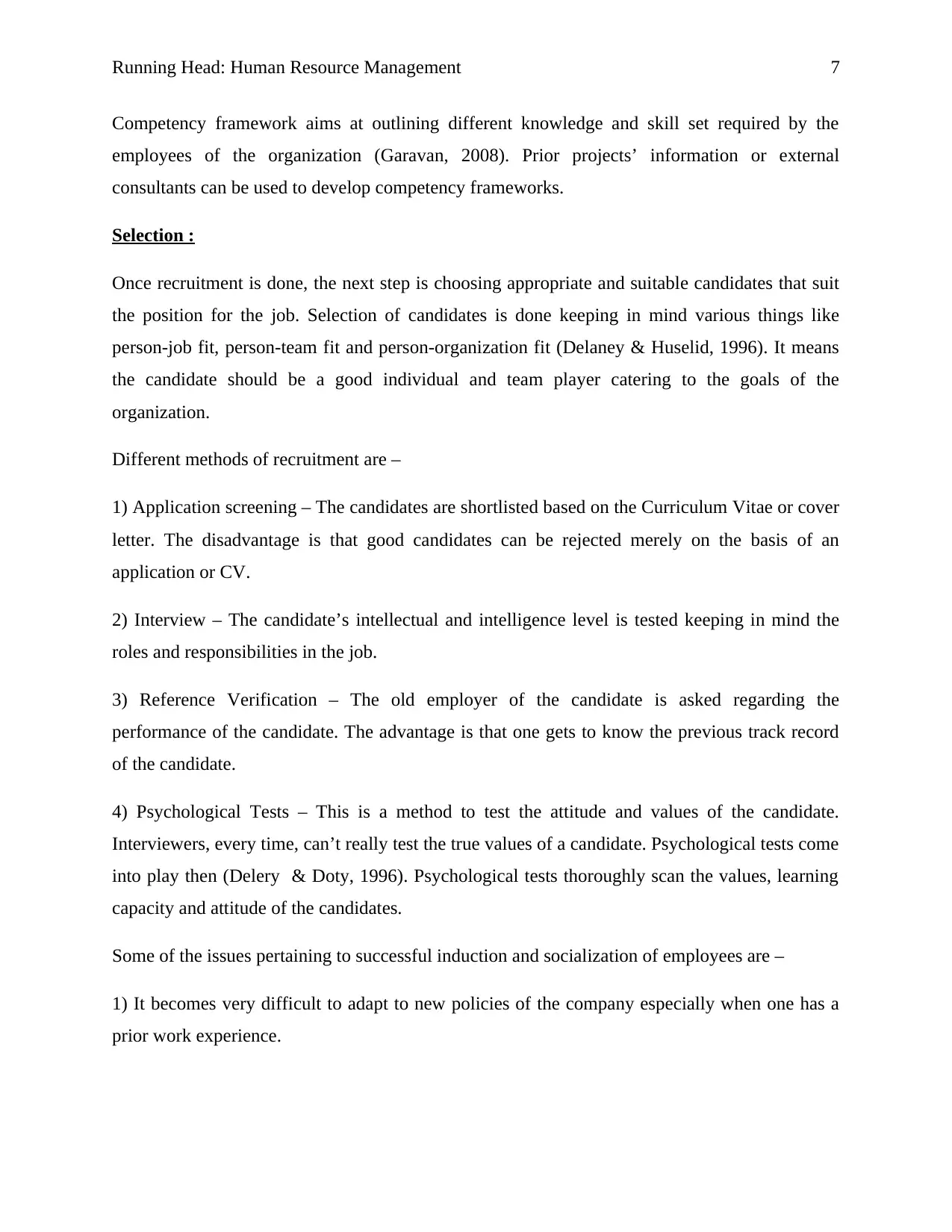
Running Head: Human Resource Management 7
Competency framework aims at outlining different knowledge and skill set required by the
employees of the organization (Garavan, 2008). Prior projects’ information or external
consultants can be used to develop competency frameworks.
Selection :
Once recruitment is done, the next step is choosing appropriate and suitable candidates that suit
the position for the job. Selection of candidates is done keeping in mind various things like
person-job fit, person-team fit and person-organization fit (Delaney & Huselid, 1996). It means
the candidate should be a good individual and team player catering to the goals of the
organization.
Different methods of recruitment are –
1) Application screening – The candidates are shortlisted based on the Curriculum Vitae or cover
letter. The disadvantage is that good candidates can be rejected merely on the basis of an
application or CV.
2) Interview – The candidate’s intellectual and intelligence level is tested keeping in mind the
roles and responsibilities in the job.
3) Reference Verification – The old employer of the candidate is asked regarding the
performance of the candidate. The advantage is that one gets to know the previous track record
of the candidate.
4) Psychological Tests – This is a method to test the attitude and values of the candidate.
Interviewers, every time, can’t really test the true values of a candidate. Psychological tests come
into play then (Delery & Doty, 1996). Psychological tests thoroughly scan the values, learning
capacity and attitude of the candidates.
Some of the issues pertaining to successful induction and socialization of employees are –
1) It becomes very difficult to adapt to new policies of the company especially when one has a
prior work experience.
Competency framework aims at outlining different knowledge and skill set required by the
employees of the organization (Garavan, 2008). Prior projects’ information or external
consultants can be used to develop competency frameworks.
Selection :
Once recruitment is done, the next step is choosing appropriate and suitable candidates that suit
the position for the job. Selection of candidates is done keeping in mind various things like
person-job fit, person-team fit and person-organization fit (Delaney & Huselid, 1996). It means
the candidate should be a good individual and team player catering to the goals of the
organization.
Different methods of recruitment are –
1) Application screening – The candidates are shortlisted based on the Curriculum Vitae or cover
letter. The disadvantage is that good candidates can be rejected merely on the basis of an
application or CV.
2) Interview – The candidate’s intellectual and intelligence level is tested keeping in mind the
roles and responsibilities in the job.
3) Reference Verification – The old employer of the candidate is asked regarding the
performance of the candidate. The advantage is that one gets to know the previous track record
of the candidate.
4) Psychological Tests – This is a method to test the attitude and values of the candidate.
Interviewers, every time, can’t really test the true values of a candidate. Psychological tests come
into play then (Delery & Doty, 1996). Psychological tests thoroughly scan the values, learning
capacity and attitude of the candidates.
Some of the issues pertaining to successful induction and socialization of employees are –
1) It becomes very difficult to adapt to new policies of the company especially when one has a
prior work experience.
Paraphrase This Document
Need a fresh take? Get an instant paraphrase of this document with our AI Paraphraser
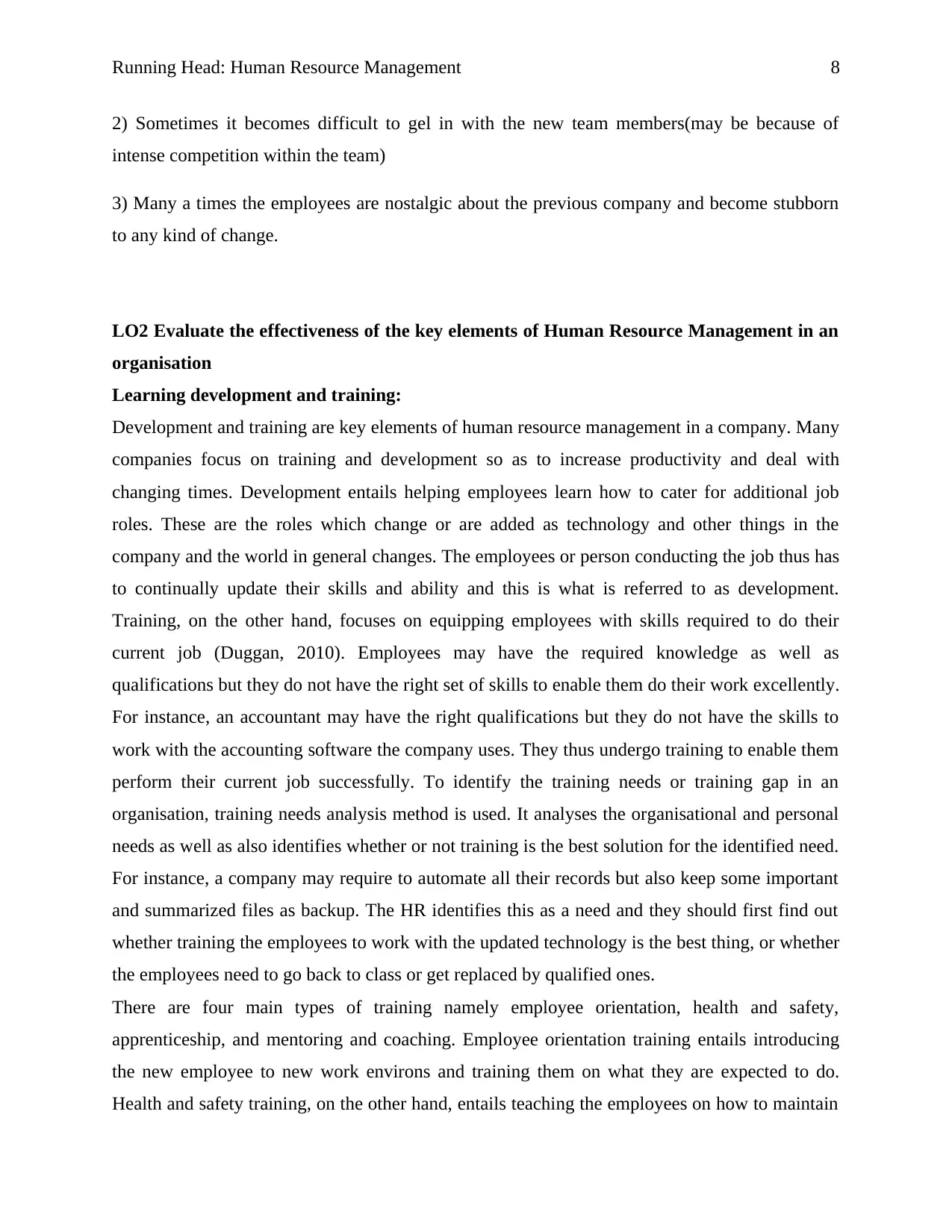
Running Head: Human Resource Management 8
2) Sometimes it becomes difficult to gel in with the new team members(may be because of
intense competition within the team)
3) Many a times the employees are nostalgic about the previous company and become stubborn
to any kind of change.
LO2 Evaluate the effectiveness of the key elements of Human Resource Management in an
organisation
Learning development and training:
Development and training are key elements of human resource management in a company. Many
companies focus on training and development so as to increase productivity and deal with
changing times. Development entails helping employees learn how to cater for additional job
roles. These are the roles which change or are added as technology and other things in the
company and the world in general changes. The employees or person conducting the job thus has
to continually update their skills and ability and this is what is referred to as development.
Training, on the other hand, focuses on equipping employees with skills required to do their
current job (Duggan, 2010). Employees may have the required knowledge as well as
qualifications but they do not have the right set of skills to enable them do their work excellently.
For instance, an accountant may have the right qualifications but they do not have the skills to
work with the accounting software the company uses. They thus undergo training to enable them
perform their current job successfully. To identify the training needs or training gap in an
organisation, training needs analysis method is used. It analyses the organisational and personal
needs as well as also identifies whether or not training is the best solution for the identified need.
For instance, a company may require to automate all their records but also keep some important
and summarized files as backup. The HR identifies this as a need and they should first find out
whether training the employees to work with the updated technology is the best thing, or whether
the employees need to go back to class or get replaced by qualified ones.
There are four main types of training namely employee orientation, health and safety,
apprenticeship, and mentoring and coaching. Employee orientation training entails introducing
the new employee to new work environs and training them on what they are expected to do.
Health and safety training, on the other hand, entails teaching the employees on how to maintain
2) Sometimes it becomes difficult to gel in with the new team members(may be because of
intense competition within the team)
3) Many a times the employees are nostalgic about the previous company and become stubborn
to any kind of change.
LO2 Evaluate the effectiveness of the key elements of Human Resource Management in an
organisation
Learning development and training:
Development and training are key elements of human resource management in a company. Many
companies focus on training and development so as to increase productivity and deal with
changing times. Development entails helping employees learn how to cater for additional job
roles. These are the roles which change or are added as technology and other things in the
company and the world in general changes. The employees or person conducting the job thus has
to continually update their skills and ability and this is what is referred to as development.
Training, on the other hand, focuses on equipping employees with skills required to do their
current job (Duggan, 2010). Employees may have the required knowledge as well as
qualifications but they do not have the right set of skills to enable them do their work excellently.
For instance, an accountant may have the right qualifications but they do not have the skills to
work with the accounting software the company uses. They thus undergo training to enable them
perform their current job successfully. To identify the training needs or training gap in an
organisation, training needs analysis method is used. It analyses the organisational and personal
needs as well as also identifies whether or not training is the best solution for the identified need.
For instance, a company may require to automate all their records but also keep some important
and summarized files as backup. The HR identifies this as a need and they should first find out
whether training the employees to work with the updated technology is the best thing, or whether
the employees need to go back to class or get replaced by qualified ones.
There are four main types of training namely employee orientation, health and safety,
apprenticeship, and mentoring and coaching. Employee orientation training entails introducing
the new employee to new work environs and training them on what they are expected to do.
Health and safety training, on the other hand, entails teaching the employees on how to maintain
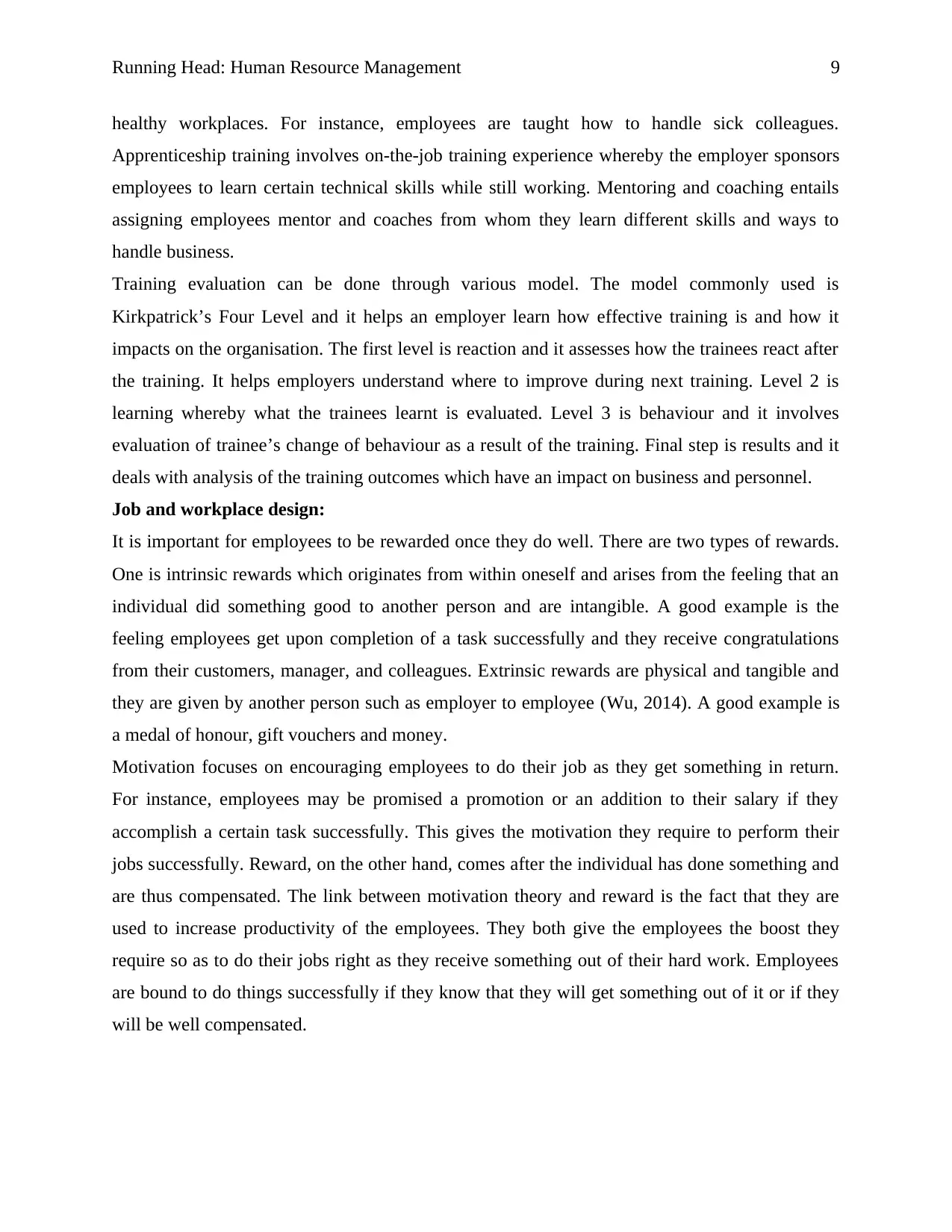
Running Head: Human Resource Management 9
healthy workplaces. For instance, employees are taught how to handle sick colleagues.
Apprenticeship training involves on-the-job training experience whereby the employer sponsors
employees to learn certain technical skills while still working. Mentoring and coaching entails
assigning employees mentor and coaches from whom they learn different skills and ways to
handle business.
Training evaluation can be done through various model. The model commonly used is
Kirkpatrick’s Four Level and it helps an employer learn how effective training is and how it
impacts on the organisation. The first level is reaction and it assesses how the trainees react after
the training. It helps employers understand where to improve during next training. Level 2 is
learning whereby what the trainees learnt is evaluated. Level 3 is behaviour and it involves
evaluation of trainee’s change of behaviour as a result of the training. Final step is results and it
deals with analysis of the training outcomes which have an impact on business and personnel.
Job and workplace design:
It is important for employees to be rewarded once they do well. There are two types of rewards.
One is intrinsic rewards which originates from within oneself and arises from the feeling that an
individual did something good to another person and are intangible. A good example is the
feeling employees get upon completion of a task successfully and they receive congratulations
from their customers, manager, and colleagues. Extrinsic rewards are physical and tangible and
they are given by another person such as employer to employee (Wu, 2014). A good example is
a medal of honour, gift vouchers and money.
Motivation focuses on encouraging employees to do their job as they get something in return.
For instance, employees may be promised a promotion or an addition to their salary if they
accomplish a certain task successfully. This gives the motivation they require to perform their
jobs successfully. Reward, on the other hand, comes after the individual has done something and
are thus compensated. The link between motivation theory and reward is the fact that they are
used to increase productivity of the employees. They both give the employees the boost they
require so as to do their jobs right as they receive something out of their hard work. Employees
are bound to do things successfully if they know that they will get something out of it or if they
will be well compensated.
healthy workplaces. For instance, employees are taught how to handle sick colleagues.
Apprenticeship training involves on-the-job training experience whereby the employer sponsors
employees to learn certain technical skills while still working. Mentoring and coaching entails
assigning employees mentor and coaches from whom they learn different skills and ways to
handle business.
Training evaluation can be done through various model. The model commonly used is
Kirkpatrick’s Four Level and it helps an employer learn how effective training is and how it
impacts on the organisation. The first level is reaction and it assesses how the trainees react after
the training. It helps employers understand where to improve during next training. Level 2 is
learning whereby what the trainees learnt is evaluated. Level 3 is behaviour and it involves
evaluation of trainee’s change of behaviour as a result of the training. Final step is results and it
deals with analysis of the training outcomes which have an impact on business and personnel.
Job and workplace design:
It is important for employees to be rewarded once they do well. There are two types of rewards.
One is intrinsic rewards which originates from within oneself and arises from the feeling that an
individual did something good to another person and are intangible. A good example is the
feeling employees get upon completion of a task successfully and they receive congratulations
from their customers, manager, and colleagues. Extrinsic rewards are physical and tangible and
they are given by another person such as employer to employee (Wu, 2014). A good example is
a medal of honour, gift vouchers and money.
Motivation focuses on encouraging employees to do their job as they get something in return.
For instance, employees may be promised a promotion or an addition to their salary if they
accomplish a certain task successfully. This gives the motivation they require to perform their
jobs successfully. Reward, on the other hand, comes after the individual has done something and
are thus compensated. The link between motivation theory and reward is the fact that they are
used to increase productivity of the employees. They both give the employees the boost they
require so as to do their jobs right as they receive something out of their hard work. Employees
are bound to do things successfully if they know that they will get something out of it or if they
will be well compensated.
⊘ This is a preview!⊘
Do you want full access?
Subscribe today to unlock all pages.

Trusted by 1+ million students worldwide
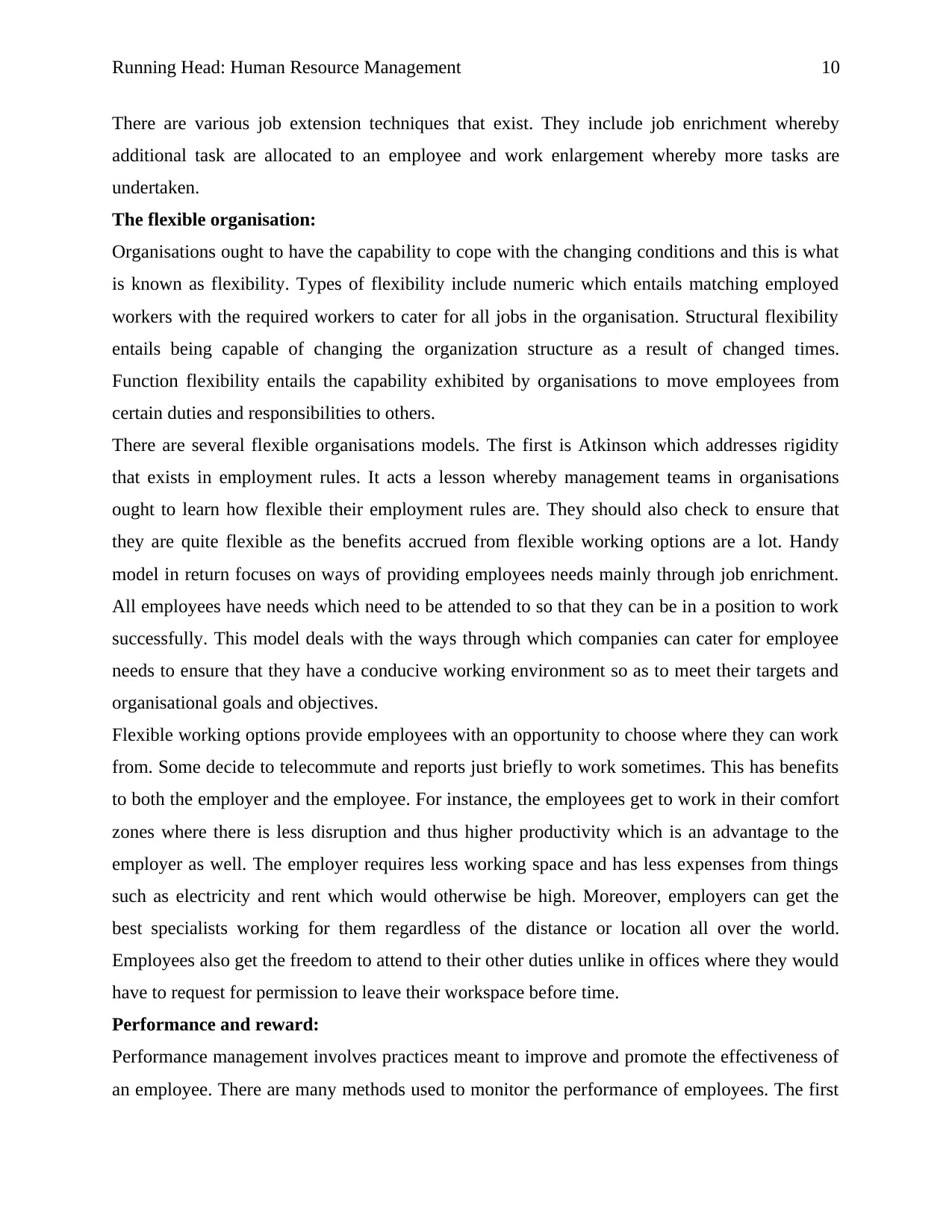
Running Head: Human Resource Management 10
There are various job extension techniques that exist. They include job enrichment whereby
additional task are allocated to an employee and work enlargement whereby more tasks are
undertaken.
The flexible organisation:
Organisations ought to have the capability to cope with the changing conditions and this is what
is known as flexibility. Types of flexibility include numeric which entails matching employed
workers with the required workers to cater for all jobs in the organisation. Structural flexibility
entails being capable of changing the organization structure as a result of changed times.
Function flexibility entails the capability exhibited by organisations to move employees from
certain duties and responsibilities to others.
There are several flexible organisations models. The first is Atkinson which addresses rigidity
that exists in employment rules. It acts a lesson whereby management teams in organisations
ought to learn how flexible their employment rules are. They should also check to ensure that
they are quite flexible as the benefits accrued from flexible working options are a lot. Handy
model in return focuses on ways of providing employees needs mainly through job enrichment.
All employees have needs which need to be attended to so that they can be in a position to work
successfully. This model deals with the ways through which companies can cater for employee
needs to ensure that they have a conducive working environment so as to meet their targets and
organisational goals and objectives.
Flexible working options provide employees with an opportunity to choose where they can work
from. Some decide to telecommute and reports just briefly to work sometimes. This has benefits
to both the employer and the employee. For instance, the employees get to work in their comfort
zones where there is less disruption and thus higher productivity which is an advantage to the
employer as well. The employer requires less working space and has less expenses from things
such as electricity and rent which would otherwise be high. Moreover, employers can get the
best specialists working for them regardless of the distance or location all over the world.
Employees also get the freedom to attend to their other duties unlike in offices where they would
have to request for permission to leave their workspace before time.
Performance and reward:
Performance management involves practices meant to improve and promote the effectiveness of
an employee. There are many methods used to monitor the performance of employees. The first
There are various job extension techniques that exist. They include job enrichment whereby
additional task are allocated to an employee and work enlargement whereby more tasks are
undertaken.
The flexible organisation:
Organisations ought to have the capability to cope with the changing conditions and this is what
is known as flexibility. Types of flexibility include numeric which entails matching employed
workers with the required workers to cater for all jobs in the organisation. Structural flexibility
entails being capable of changing the organization structure as a result of changed times.
Function flexibility entails the capability exhibited by organisations to move employees from
certain duties and responsibilities to others.
There are several flexible organisations models. The first is Atkinson which addresses rigidity
that exists in employment rules. It acts a lesson whereby management teams in organisations
ought to learn how flexible their employment rules are. They should also check to ensure that
they are quite flexible as the benefits accrued from flexible working options are a lot. Handy
model in return focuses on ways of providing employees needs mainly through job enrichment.
All employees have needs which need to be attended to so that they can be in a position to work
successfully. This model deals with the ways through which companies can cater for employee
needs to ensure that they have a conducive working environment so as to meet their targets and
organisational goals and objectives.
Flexible working options provide employees with an opportunity to choose where they can work
from. Some decide to telecommute and reports just briefly to work sometimes. This has benefits
to both the employer and the employee. For instance, the employees get to work in their comfort
zones where there is less disruption and thus higher productivity which is an advantage to the
employer as well. The employer requires less working space and has less expenses from things
such as electricity and rent which would otherwise be high. Moreover, employers can get the
best specialists working for them regardless of the distance or location all over the world.
Employees also get the freedom to attend to their other duties unlike in offices where they would
have to request for permission to leave their workspace before time.
Performance and reward:
Performance management involves practices meant to improve and promote the effectiveness of
an employee. There are many methods used to monitor the performance of employees. The first
Paraphrase This Document
Need a fresh take? Get an instant paraphrase of this document with our AI Paraphraser
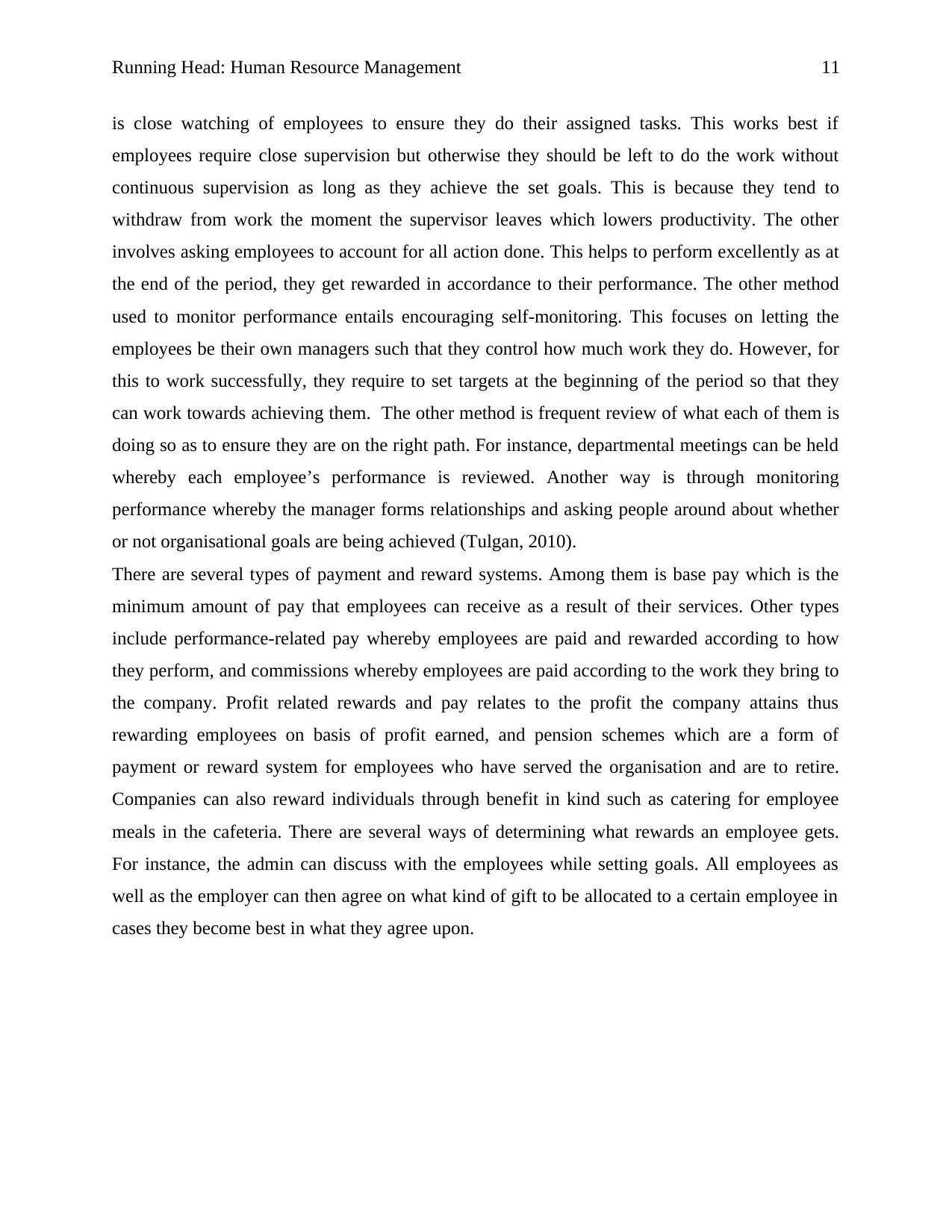
Running Head: Human Resource Management 11
is close watching of employees to ensure they do their assigned tasks. This works best if
employees require close supervision but otherwise they should be left to do the work without
continuous supervision as long as they achieve the set goals. This is because they tend to
withdraw from work the moment the supervisor leaves which lowers productivity. The other
involves asking employees to account for all action done. This helps to perform excellently as at
the end of the period, they get rewarded in accordance to their performance. The other method
used to monitor performance entails encouraging self-monitoring. This focuses on letting the
employees be their own managers such that they control how much work they do. However, for
this to work successfully, they require to set targets at the beginning of the period so that they
can work towards achieving them. The other method is frequent review of what each of them is
doing so as to ensure they are on the right path. For instance, departmental meetings can be held
whereby each employee’s performance is reviewed. Another way is through monitoring
performance whereby the manager forms relationships and asking people around about whether
or not organisational goals are being achieved (Tulgan, 2010).
There are several types of payment and reward systems. Among them is base pay which is the
minimum amount of pay that employees can receive as a result of their services. Other types
include performance-related pay whereby employees are paid and rewarded according to how
they perform, and commissions whereby employees are paid according to the work they bring to
the company. Profit related rewards and pay relates to the profit the company attains thus
rewarding employees on basis of profit earned, and pension schemes which are a form of
payment or reward system for employees who have served the organisation and are to retire.
Companies can also reward individuals through benefit in kind such as catering for employee
meals in the cafeteria. There are several ways of determining what rewards an employee gets.
For instance, the admin can discuss with the employees while setting goals. All employees as
well as the employer can then agree on what kind of gift to be allocated to a certain employee in
cases they become best in what they agree upon.
is close watching of employees to ensure they do their assigned tasks. This works best if
employees require close supervision but otherwise they should be left to do the work without
continuous supervision as long as they achieve the set goals. This is because they tend to
withdraw from work the moment the supervisor leaves which lowers productivity. The other
involves asking employees to account for all action done. This helps to perform excellently as at
the end of the period, they get rewarded in accordance to their performance. The other method
used to monitor performance entails encouraging self-monitoring. This focuses on letting the
employees be their own managers such that they control how much work they do. However, for
this to work successfully, they require to set targets at the beginning of the period so that they
can work towards achieving them. The other method is frequent review of what each of them is
doing so as to ensure they are on the right path. For instance, departmental meetings can be held
whereby each employee’s performance is reviewed. Another way is through monitoring
performance whereby the manager forms relationships and asking people around about whether
or not organisational goals are being achieved (Tulgan, 2010).
There are several types of payment and reward systems. Among them is base pay which is the
minimum amount of pay that employees can receive as a result of their services. Other types
include performance-related pay whereby employees are paid and rewarded according to how
they perform, and commissions whereby employees are paid according to the work they bring to
the company. Profit related rewards and pay relates to the profit the company attains thus
rewarding employees on basis of profit earned, and pension schemes which are a form of
payment or reward system for employees who have served the organisation and are to retire.
Companies can also reward individuals through benefit in kind such as catering for employee
meals in the cafeteria. There are several ways of determining what rewards an employee gets.
For instance, the admin can discuss with the employees while setting goals. All employees as
well as the employer can then agree on what kind of gift to be allocated to a certain employee in
cases they become best in what they agree upon.
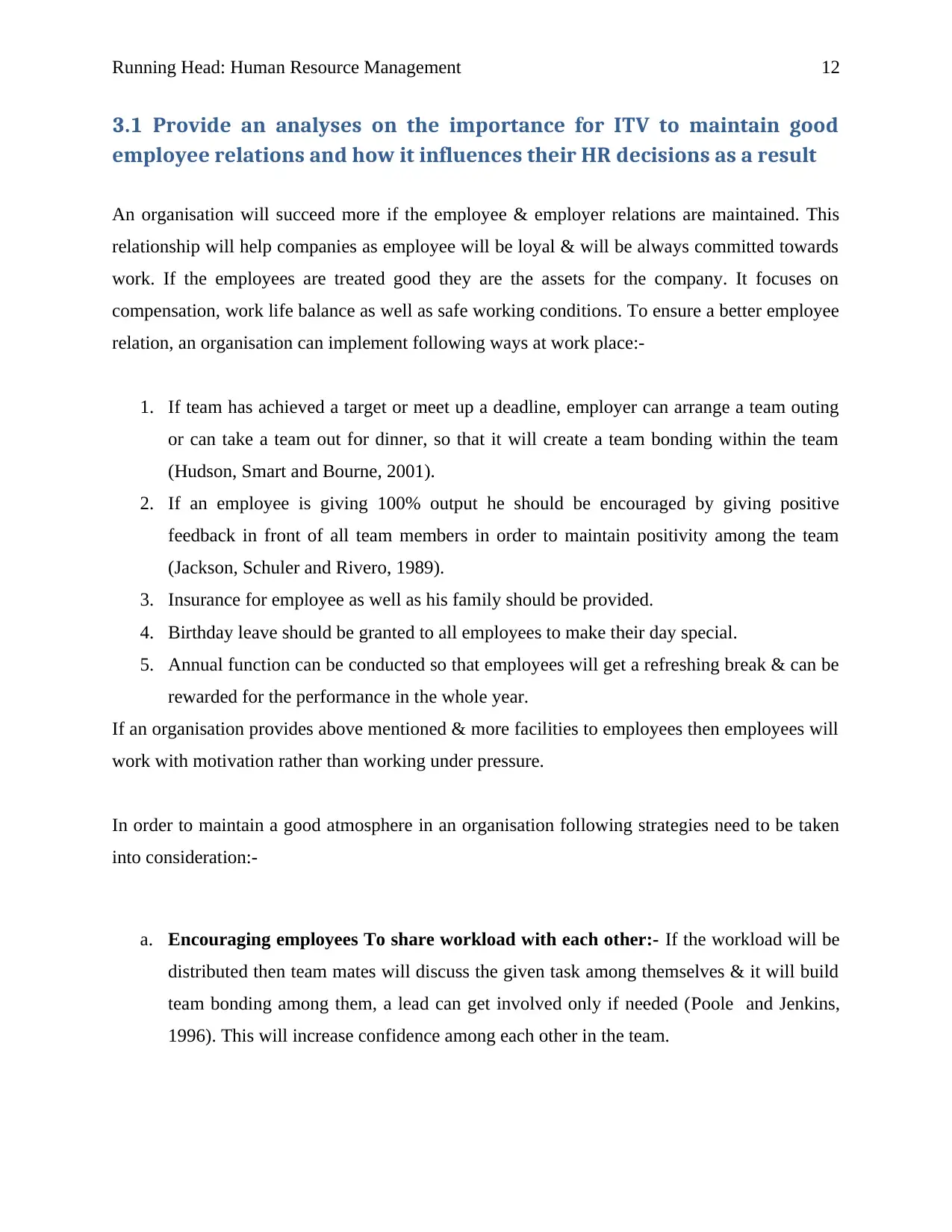
Running Head: Human Resource Management 12
3.1 Provide an analyses on the importance for ITV to maintain good
employee relations and how it influences their HR decisions as a result
An organisation will succeed more if the employee & employer relations are maintained. This
relationship will help companies as employee will be loyal & will be always committed towards
work. If the employees are treated good they are the assets for the company. It focuses on
compensation, work life balance as well as safe working conditions. To ensure a better employee
relation, an organisation can implement following ways at work place:-
1. If team has achieved a target or meet up a deadline, employer can arrange a team outing
or can take a team out for dinner, so that it will create a team bonding within the team
(Hudson, Smart and Bourne, 2001).
2. If an employee is giving 100% output he should be encouraged by giving positive
feedback in front of all team members in order to maintain positivity among the team
(Jackson, Schuler and Rivero, 1989).
3. Insurance for employee as well as his family should be provided.
4. Birthday leave should be granted to all employees to make their day special.
5. Annual function can be conducted so that employees will get a refreshing break & can be
rewarded for the performance in the whole year.
If an organisation provides above mentioned & more facilities to employees then employees will
work with motivation rather than working under pressure.
In order to maintain a good atmosphere in an organisation following strategies need to be taken
into consideration:-
a. Encouraging employees To share workload with each other:- If the workload will be
distributed then team mates will discuss the given task among themselves & it will build
team bonding among them, a lead can get involved only if needed (Poole and Jenkins,
1996). This will increase confidence among each other in the team.
3.1 Provide an analyses on the importance for ITV to maintain good
employee relations and how it influences their HR decisions as a result
An organisation will succeed more if the employee & employer relations are maintained. This
relationship will help companies as employee will be loyal & will be always committed towards
work. If the employees are treated good they are the assets for the company. It focuses on
compensation, work life balance as well as safe working conditions. To ensure a better employee
relation, an organisation can implement following ways at work place:-
1. If team has achieved a target or meet up a deadline, employer can arrange a team outing
or can take a team out for dinner, so that it will create a team bonding within the team
(Hudson, Smart and Bourne, 2001).
2. If an employee is giving 100% output he should be encouraged by giving positive
feedback in front of all team members in order to maintain positivity among the team
(Jackson, Schuler and Rivero, 1989).
3. Insurance for employee as well as his family should be provided.
4. Birthday leave should be granted to all employees to make their day special.
5. Annual function can be conducted so that employees will get a refreshing break & can be
rewarded for the performance in the whole year.
If an organisation provides above mentioned & more facilities to employees then employees will
work with motivation rather than working under pressure.
In order to maintain a good atmosphere in an organisation following strategies need to be taken
into consideration:-
a. Encouraging employees To share workload with each other:- If the workload will be
distributed then team mates will discuss the given task among themselves & it will build
team bonding among them, a lead can get involved only if needed (Poole and Jenkins,
1996). This will increase confidence among each other in the team.
⊘ This is a preview!⊘
Do you want full access?
Subscribe today to unlock all pages.

Trusted by 1+ million students worldwide
1 out of 21
Related Documents
Your All-in-One AI-Powered Toolkit for Academic Success.
+13062052269
info@desklib.com
Available 24*7 on WhatsApp / Email
![[object Object]](/_next/static/media/star-bottom.7253800d.svg)
Unlock your academic potential
Copyright © 2020–2025 A2Z Services. All Rights Reserved. Developed and managed by ZUCOL.





